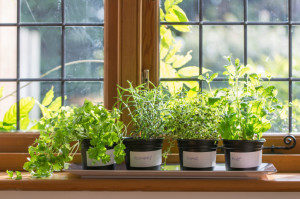How to Make an Indoor Garden for Fresher Cooking
Gardening is an enjoyable and rewarding activity, but many people find it impossible to do depending on their living situation. However, what a lot of people don’t realize is that even people without yards can still put their green thumb to good use. There are a number of plants that survive well indoors.
Learn how to create your own indoor garden that will provide you with food and herbs throughout the year.
The first step to having a successful indoor garden is finding a spot near a window with plenty of natural light (6 to 8 hours per day.) It doesn’t hurt to give your plants some light from LEDs along with the sunlight if you can. If you have access to these kinds of lights, then there is no reason for you not to garden year-round! If you don’t have enough natural sunlight coming in through your windows, then you may need to stick with growing succulents or invest in some grow lights. Another important element of choosing a room for your garden is how warm it is. The temperature of

the soil is just as important as the amount of sunlight. Make sure that the room is constantly between 60 and 70 degrees. Don’t keep them in a chilly place like a basement.
Depending on your level of gardening skills, you can either begin your plants from seeds or purchase seedlings at your local garden store. Seedlings are much easier to grow because they have already grown roots and have sprouted leaves to suck in all of the sunlight. However, buying packages of seeds will be cheaper and you’ll have plenty of seeds in case your first try doesn’t go so well.
Herbs tend to be the easiest indoor gardening plant because they don’t take up a lot of space. Just make sure to give mint its own container, because it is considered a weed and will take over your other plants. You can also plant certain vegetables in pots, including peas and lettuce.
Find a small container to start your seeds. Egg cartons are perfect because they are porous, and are biodegradable if you eventually want to plan your seedlings in the ground. You can also make individual containers for your plants out of toilet paper rolls with the bottoms folded to hold in the soil. Flower pots work well for larger plants (just make sure not to plant the seeds too deep.) Make sure that you place a dish under any container that you use that has drainage holes so the water doesn’t leak all over your floor.
If you plan to transplant seeds outdoors when the time comes, make sure to check the zones on the back of your seed packages. This map will let you know during which months you should plant each seed so that they are the right size if you do end up transplanting them.
Purchase soil specifically made for starting seeds to ensure that it is packed with the right nutrients. Don’t pack it too tightly, as the soil will need to be able to drain. Your seed package will tell you how deeply you should plant them.
Watering can be tricky… because yes, it is possible to over-water your plants. In case you do over-water, it’s a good idea for your container to have holes for drainage so that you don’t drown your plant. Yellowing leaves are the first sign of over-watering. The soil should always be damp, like a wrung out sponge. If you’re having difficulty holding in moisture, instead of watering the plant more, put it inside of a gallon Ziploc bag and this will create your own mini greenhouse.
Make sure to regularly prune your plants to encourage more growth. If you are growing basil, the stalk will begin to sprout flowers, and you’ll want to remove the growth to encourage more leaves to grow.
Indoor gardens are great because they allow you the luxury of cooking with fresh herbs at any time! Here at Salem Cross Inn, we love having that luxury. A majority of our dishes are created from produce straight out of our garden, leaving you with the freshest tasting meals possible. Make your reservation and visit us today!







